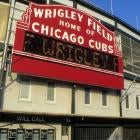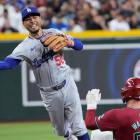To the extent there is a precedent, it's not a familiar one. A global pandemic of unknown and at times misunderstood scope has halted all of sports, baseball prominent among them. While the particulars of the novel coronavirus and MLB's reaction to it are unique, the notion of a compromised season -- one whittled down or delayed by outside forces -- has been realized before.
Throughout the sprawl of modern MLB history, no fewer than 14 seasons, including the elusive 2020 edition, have been abbreviated or delayed to some extent. As we proceed into baseball's unknown, let's look back at those instances, some of which will ring of the familiar and some of which have been largely forgotten.
1904
The World Series era began in 1903 when Ban Johnson's fledgling American League -- a former minor-league circuit that aspired to major-league standing -- leveraged its way into a working agreement with the more established National League. After some poaching of players from NL rosters and the AL's incursion into the New York City market, NL owners decided peace, uneasy or otherwise, was the most sensible tack. The National Agreement recognized the two leagues as equals and yoked them together forevermore. The 1903 World Series -- the first to pit the NL champion against the AL champion -- established the signature event that prevails to this day. In that first World Series, Cy Young and the Boston Americans vanquished Honus Wagner and the Pittsburgh Pirates.
The following year, 1904, proceeded as planned until the World Series between Boston and the New York Giants. Giants owner John T. Brush was still enraged that the American League had put a team in Gotham -- the Highlanders, who would become the Yankees -- and he refused to allow his Giants to play in the World Series against the presumptuous American Leaguers. Indeed, no World Series was played in 1904.
The Fall Classic was back in clover in 1905 thanks to the "John T. Brush Rules" -- named for the Giants' recalcitrant steward, who objected to the haphazard nature of the World Series structure -- that most notably established the series as a best-of-seven affair and laid down rules for splitting gate receipts and player bonuses.
1918-19
In April of 1917, the U.S. declared war on Germany and thus entered World War I, then known as the Great War. The following year, U.S. Secretary of War Newton D. Baker issued a "work or fight" edict, in which able-bodied men were required to enlist or work in civilian industries deemed necessary to the war effort. By the midsummer, rosters were significantly compromised because of conscription. MLB was forced to end the 1918 regular season on Sept. 2 -- non-essential industry was to shut down by Labor Day -- and was allowed to resume only for the playing of the World Series over a span of two weeks. Teams wound up playing between 122 and 129 games that season rather than the scheduled 140 (prior to the season, owners had agreed to scale back from the usual 154 games because of the war effort).
Not long after the Red Sox defeated the Cubs in the 1918 World Series, the war ended. However, the global conflict reverberated into the following year, and the 1919 season didn't get underway until late April. As was the initial intent in 1918, the 1919 regular season was shortened to 140 games.
This is to say nothing of the 1918 flu pandemic, which affected Major League Baseball most acutely when revered umpire Silk O'Loughlin fell prey to the malady. As well, a number of former players died as a result of a global pandemic, as did rising Negro Leagues star Ted Kimbro. In the absence of war, it's possible and perhaps likely the "Spanish flu" outbreak would've interrupted the 1918 season, but the official cause for those disruptions in baseball is America's entry into armed conflict.
1944
FDR memorably implored commissioner Kenesaw Mountain Landis to keep baseball during World War II, for purposes of uplift and consoling distraction, with his January 1942 "Green Light Letter." Baseball did just that, even though it had to make do with patchwork rosters during the heart of the war. To mark D-Day, in which more than three million allied troops conducted an amphibious assault on the beaches of Normandy, all manner of sporting events were cancelled on June 6, 1944. Just two MLB games were on the schedule for that day -- National League tilts in Brooklyn and Pittsburgh -- and each was moved to another date.
1972
The first players' strike in MLB history lasted 13 days, delayed the start of the '72 regular season, and forced a week of games to be canceled. The season began on April 15 and proceeded according to the schedule in place. That meant teams wound up playing different numbers of games. This was most keenly felt in the AL East, in which the Tigers edged the Red Sox for the division title by a mere half-game. The two teams were even in the loss column. The strike ended when owners agreed to contribute an additional $500,000 to the players' pension fund and institute salary arbitration.
1981
In '81, the players struck again, this time over the matter of free agent compensation. The labor stoppage lasted from June 12 through July 31 -- a span of 50 days in the middle of the season -- and a total of 712 games were lost. MLB responded to the disruption with a schedule format that in retrospect seems flatly cockamamie. The slice of schedule before the strike was declared the first half, and division winners from that first half were granted postseason berths. The second half of the season took place after the strike was resolved, and division winners from that span were also part of the playoff fray. Division winners from each half squared off in the expanded postseason in best of five series. The problem was that the team with the best overall record in baseball, the Reds, were left out of the playoffs because they failed to win either half. Similarly, the Cardinals owned the second-best record in the NL and also missed the postseason.
1985
The players struck for two days in August, but the dispute was resolved quickly when the owners agreed to additional pension contributions and an increase in the minimum salary. The lost games were made up.
1989
Minutes before the start of Game 3 of the 1989 World Series between the Athletics and Giants at San Francisco's Candlestick Park, an earthquake measuring 7.1 on the Richter scale assailed the Bay Area to devastating effect. What came to be known as the Loma Prieto Earthquake caused 63 deaths; almost 4,000 injuries; and billions upon billions of dollars in damage. Commissioner Fay Vincent canceled Game 3 soon after the quake subsided, and the World Series was delayed for 10 days. Eventually, the A's swept their cross-bay rivals in four games.
1990
The owners locked out players during spring training for 32 days from mid-February to mid-March. The lockout ended when owners and players agreed to additional pension payments, an increase to the minimum salary, and tweaks to the arbitration structure. Opening Day was pushed back a week, but teams were still able to play a full schedule.
1994-95
The longest and most lacerating work stoppage in the sport's history spanned 232 days and snuffed out 932 games across two seasons, including the 1994 World Series. It was largely a consequence of the owners' unrealistic demands of a salary cap. The players walked off the job on Aug. 12, 1994, and the remainder of the 1994 season was cancelled by acting commissioner Bud Selig on Sept. 14. The strike wasn't resolved until a March 1995 court order forced resumption of play under the existing labor rules through the 1996 season. Because players needed time to prepare, the 1995 season didn't begin until late April and consisted of a 144-game schedule. The two sides didn't forge a new Collective Bargaining Agreement until March of 1997.
2001
The terrorist attacks of Sept. 11, 2001, led to a postponement of all MLB games for one week. Because of the delay, the 2001 World Series between the Yankees and Diamondbacks became the first Fall Classic ever to be extended into the month of November.
2003
On March 18, MLB cancelled the season-opening series between the Athletics and Mariners, which had been scheduled to take place in Japan. The cancellation was due to the mounting threat of U.S. military action in Iraq. The two games were rescheduled for later in the season, to be played stateside, and the season instead opened with a game between the Rangers and Angels on March 30.
And that catches us up to 2020, in which the MLB season is going to be pushed back until at least May because of COVID-19. Baseball has had similar health-related scares before -- Rangers pitcher Vicente Padilla was diagnosed with H1N1 influenza (or swine flu) in July of 2009, and Freddy Galvis of the Phillies came down with a serious staph infection during spring training 2014 (the team closed and deep-cleaned its facilities) -- but nothing approaching this level of disruption.
The road forward is uncertain and surely winding, but baseball has no doubt learned from the past that novel approaches such as that of 1981 can yield unsatisfying results. As well, leaving the calendar intact, as MLB did in 1972, can also lead to unfair results. Expect teams to play the same number of games once we get around to establishing the parameters of the 2020 season. When that comes to pass is anyone's guess. Whatever the details, we'll look back upon this season as one of the great upheavals in baseball history.






















